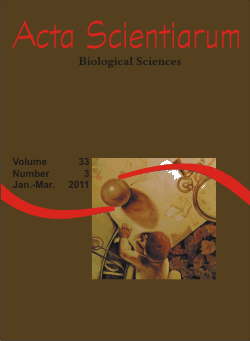<b>Identification of the <em>mcyA</em> gene in natural blooms of <em>Radiocystis fernandoi</em> from a tributary of the Rosana reservoir, Brazil</b> - doi: 10.4025/actascibiolsci.v33i3.6802
Keywords:
Cyanobacteria, toxins, PCR, Radiocystis fernandoi, mcyA
Abstract
Cyanobacterias are known as toxin producers. Within the same species, toxic and non-toxic varieties can be found and it is impossible to differentiate them only by morphology. The most important toxin produced by cyanobacteria is microcystin. This protein is synthesized by a cluster of genes known as mcy. The detection of these genes by PCR allows the differentiation of the producing toxin strain from the non-producing toxin strain. Thus, the goal of this work was to investigate the occurrence of toxigenic blooms of cyanobacteria in the Corvo River through PCR amplification of mcyA gene. For this, two samples of blooms of cyanobacteria were collected in Corvo River. Both samples were dominated by Radiocystis fernandoi and presented positive results for the presence of the mcyA gene, which may confirm the potential toxigenicity for that species. These results are an alert about water quality in the Corvo River. Here we demonstrate that amplification of the mcyA gene by PCR is a fast, cheap and efficient method for the detection of toxin- producing cyanobacteria.Downloads
Download data is not yet available.
Published
2011-04-14
How to Cite
Fonseca, I. A., Maniglia, T. C., Rodrigues, L., Prioli, A. J., & Prioli, S. M. A. P. (2011). <b>Identification of the <em>mcyA</em> gene in natural blooms of <em>Radiocystis fernandoi</em> from a tributary of the Rosana reservoir, Brazil</b> - doi: 10.4025/actascibiolsci.v33i3.6802. Acta Scientiarum. Biological Sciences, 33(3), 319-324. https://doi.org/10.4025/actascibiolsci.v33i3.6802
Issue
Section
Genetics
DECLARATION OF ORIGINALITY AND COPYRIGHTS
I Declare that current article is original and has not been submitted for publication, in part or in whole, to any other national or international journal.
The copyrights belong exclusively to the authors. Published content is licensed under Creative Commons Attribution 4.0 (CC BY 4.0) guidelines, which allows sharing (copy and distribution of the material in any medium or format) and adaptation (remix, transform, and build upon the material) for any purpose, even commercially, under the terms of attribution.
Read this link for further information on how to use CC BY 4.0 properly.
0.6
2019CiteScore
31st percentile
Powered by 

0.6
2019CiteScore
31st percentile
Powered by 











1.png)




3.png)













